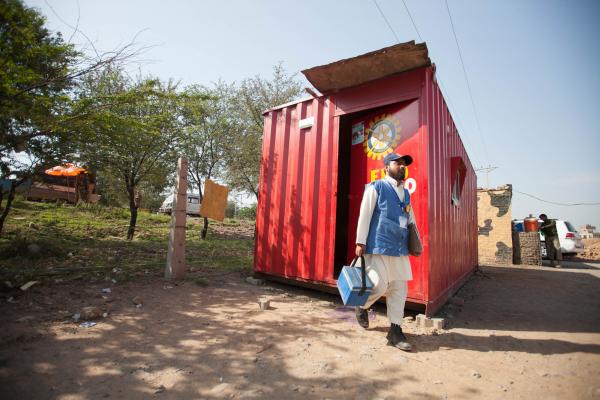Pakistan's Rise to Zero
Pakistan and Rotary are cutting through a whirl of migrating families and cultural barriers to turn what was 'a badge of shame' into a model for disease eradication.
At a busy toll plaza in Kohat, Pakistan, a three-member vaccination team is working fast.
Outfitted in blue Rotary vests and flanked by armed military personnel, the vaccinators approach a white van as it pulls away from the scattered stream of traffic, cars rattling east toward Islamabad and west to the nearby border with Afghanistan. One worker leans toward the driver to ask a question as another reaches into a cooler to prepare the vaccine. Among the crush of passengers in the van, they identify one child who has not yet been vaccinated.
There is no time for second-guessing.
There is not even enough room for the boy to crawl toward the front of the vehicle or through one of the doors; a relative must hand the young child to the vaccinators through one of the rear windows. He is quickly inoculated with two drops of oral polio vaccine, and his pinkie finger is stained with purple ink to indicate that he’s received his dose. He cries as the vaccinator hurriedly passes him back through the window. The van speeds off, fading back into the dizzying hum of traffic, as the vaccinators look for the next car and child.
This scene plays out thousands of times a day at transit posts like this one — makeshift vaccination clinics set up at bus stops, border crossings, army posts, and police checkpoints across the country in an effort to reach children who are on the move.
Here in Pakistan, home to almost all of the world’s polio cases just a few years ago, these moving targets require a vaccination strategy as agile and stubborn as the virus itself. At hundreds of sites, teams of health workers verify that every child passing through receives the vaccine.
The interaction is fleeting — faster than getting a meal at a drive-through restaurant — but the benefit is permanent. Another child, another family, another generation is protected, and Pakistan moves one step closer to having zero polio cases.
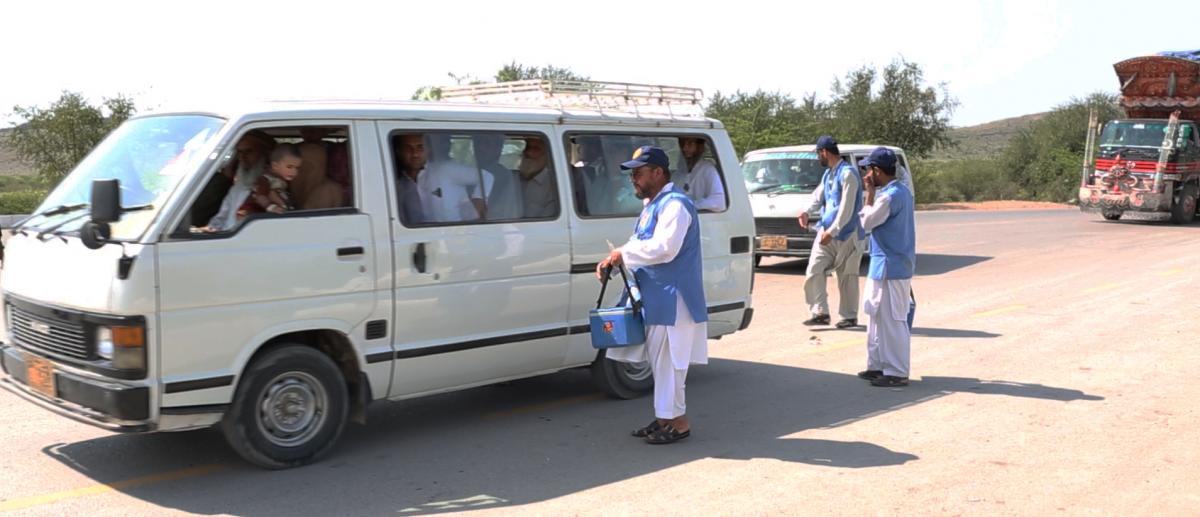
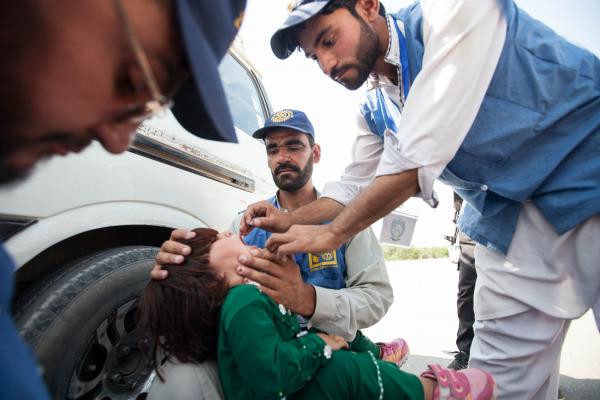
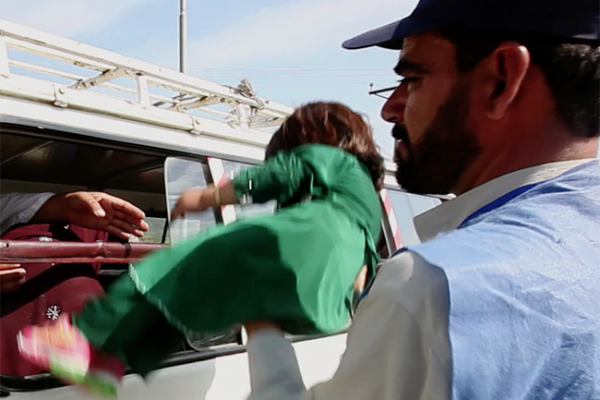
More than 700 children are vaccinated daily at the busy Kohat Toll Plaza, which borders Khyber Pakhtunkhawa and the Federally Administered Tribal Areas.
Photos by Khaula Jamil
Setback year
In 2014, Pakistan’s effort to wipe out polio, a disease that can paralyze, was in crisis.
Political pressure to root out the virus was being tested, reports of violence against vaccinators were common, and perceptions that the country was an incubator of the disease grew. Massive population movement and displacement had pushed the anti-polio campaign to its limit.
The consequence? Reports of the disease spiked to alarming levels.
The explosive outbreak that year totaled 306 reported cases, up from 93 the previous year. Pakistan had 82 percent of the world’s cases of polio in 2014. One newspaper editorial at the time called the epidemic Pakistan’s “badge of shame.”
Dr. Rana Safdar, director of the National Emergency Operations Center in Pakistan, on the success of Rotary’s PolioPlus strategy.
A pointed 2014 report from the Independent Monitoring Board of the Global Polio Eradication Initiative spotlighted Pakistan’s missteps, humbling government leaders and health officials, who scrambled to find solutions.
“We were emotional and somewhat defensive,” says Dr. Rana Safdar, director of the National Emergency Operations Center in Pakistan. “But the report pushed us to get our act together on polio, for first time. Our program was a threat to the global polio eradication efforts. The upsurge we had in Pakistan was unprecedented.”
The government effectively declared war on polio, condemning the outbreak as a national disaster. Words were soon matched with action.
“The motivation and the commitment of the vaccinators on the front line and government officials became stronger,” says Aziz Memon, chair of Rotary’s Pakistan PolioPlus Committee. “We had more reason to say, ‘Yes, we need to get rid of this disease and fulfill the promise we made to the children of this country: No child in the future will be crippled by this disease.’”
Led by this renewed commitment, the country rallied, intensifying immunizations through new strategies that resulted in a dramatic decrease in polio cases over the next two years.
The number of new infections dropped from 306 in 2014 to 56 the next year, a decrease of 82 percent. In 2016, only 15 cases of polio caused by the wild virus were reported.
‘A paradigm shift’
‘A paradigm shift’
To quell spread of the disease and reduce the risk of exporting cases to neighboring countries, Pakistan adopted a National Emergency Action Plan. The immediate goals: to cut off transmission of the virus in high-risk areas and to reach missed children.
Polio cases in Pakistan
2016: 19
2015: 54 cases
2014: 304 cases
2013: 93 cases
2012: 58 cases
Routine vaccination campaigns that immunize children door to door were no longer enough. Calling it a “paradigm shift in strategy,” Senator Ayesha Farooq, who leads the anti-polio strategy for the prime minister in Pakistan, says the revitalized program focuses heavily on children who have routinely missed vaccinations.
“Despite the fact we were receiving 80 percent coverage in every campaign, the other 10 to 20 percent that we were missing out on were sustaining the virus,” she says.
Rotary launched the world’s first global polio immunization program, PolioPlus, in 1985. In 1988, it became a founding partner of the Global Polio Eradication Initiative (GPEI). It continues to work for polio eradication with the World Health Organization, UNICEF, the U.S. Centers for Disease Control and Prevention, and the Bill & Melinda Gates Foundation.
Rotary has contributed more than $1.6 billion and countless volunteer hours to immunize more than 2.5 billion children worldwide. Polio cases have plummeted by more than 99.9 percent, from 350,000 cases in 1988 to 27 in 2016.
Vaccinators track a population in motion
For nearly four years, from 2012 to 2015, half a million children in the Federally Administered Tribal Areas in northwestern Pakistan were inaccessible to vaccinators.
The mountainous, semiautonomous region, including North Waziristan, was controlled by militant groups such as the Taliban, which prohibited polio vaccinations.
These areas were not under-vaccinated; the children were not immunized at all.
This fueled the 2014 outbreaks, with about 70 percent of cases coming from the tribal areas.
After a sweeping military offensive in 2015 pushed the Taliban out of the northern tribal region, more than 1 million civilians fled to neighboring areas and across the border into Afghanistan.
Inside the Jalozai Camp for Internally Displaced Persons.
The military action created a refugee crisis, putting tens of thousands of people in camps for the internally displaced.
Still, it also cleared the way for vaccinators to inoculate hundreds of previously inaccessible children, says Dr. Malek Sbih, leader of WHO’s strategy of vaccinating children as they travel.
“The military operation provoked an enormous exodus of people from the region, inside and outside the borders. It’s unfortunate. But fortunately for us, it gave us the opportunity to reach 265,000 kids,” he says.
According to Sbih, who had previously worked to stem the cholera epidemic in Haiti after the 2010 earthquake, polio vaccinations more than doubled, from 11 million in 2013 to 24 million in 2015.
But even today, as vaccinations are up and new cases are down, the country’s high rate of population movement — travelers headed to religious festivals, migrant workers, nomads — poses a daily challenge to the polio campaign.
“Population movement from under-immunized and high-risk areas plays a huge role in the spreading of the polio virus,” Sbih says. “The challenge really is to adapt on the ground to these specific movements.”
To do this, Pakistan and the GPEI partners had more than 200,000 trained and dedicated front-line vaccinators fan out to Karachi, Khyber Pakhtunkhwa, and Quetta, the three core reservoirs of wild poliovirus.
The boosted campaigns also installed more than 600 permanent transit posts across the country. Known as PTPs, these kiosks operate year-round and provide millions of vaccinations to children and families who are away from home or otherwise on the move.
From Karachi in the south to Islamabad and the tribal areas in the north, Rotary has negotiated to place PTPs in high-traffic areas, including highways, toll plazas, train and bus stations, airports, markets, and even amusement parks.
As the infection rate dropped, the polio program changed its emphasis from quantity to quality, reducing the number of posts from over 600 to fewer than about 400. The remaining posts operate at strategic sites along busy interprovincial and international borders and in the core poliovirus reservoirs.
Rotary has directly funded more than 30 robust PTPs, outfitting repurposed shipping containers with solar-powered refrigeration and furniture. Each is staffed by security personnel as well. These additions are crucial at posts that require round-the-clock service and staff.
“Many of our strategically devised PTPs lacked basic facilities,” says Safdar, of Pakistan’s emergency operations center. “Because of the urgent needs of the PTP program, we were really blessed that Rotary came to the rescue of this program. They have been helping us with this strategy from the beginning. When we needed them to be present, they were there, supporting us.”
And no one in the effort is more important than those operating along the 1,500-mile (roughly 2,500-kilometer) boundary between Afghanistan and northern and western Pakistan, a porous border that accounts for 90 percent of Pakistan’s population movement.
“The people on the move in this region are generally under-immunized and are not caught on either side of the border during routine vaccination campaigns,” says Senator Farooq. “Cross-border PTPs and vaccination efforts are very, very critical to the success of the program. We are concentrating on ensuring that people crossing borders from each side are vaccinated.”
Recently the two governments agreed to work closely on synchronized immunization campaigns.
Because Pakistan and Afghanistan are part of the same epidemiological block, Farooq says, “we have to work in tandem with our Afghan partners to eradicate polio from the region altogether. We need to build immunity so that there is no cross-border importation.”
In July, Rotary bolstered this effort by opening a massive PTP at the Friendship Gate, a border checkpoint in the Chaman area in northern Baluchistan. Along with migrants, each day, between 10,000 and 15,000 Pakistani and Afghan traders pass through the gate.
The vital Friendship Gate PTP has two large rooms, a lounge, a kitchen, and washrooms. According to Rotary’s Memon, more than 1,000 children are vaccinated there each day.
In total, the PTP strategy has vaccinated more than 68 million children who would otherwise be missed. “Without the support of Rotary,” says WHO team leader Sbih, “it would have been much more difficult to vaccinate these kids and give our teams on the ground the resources they need.”
Refusing to lose
Regardless of how thorough the improved vaccination campaigns are, the overall polio eradication effort in Pakistan hinges on a single, crucial touch point: community trust.
“This is where the rubber hits the road,” says Aidan O’Leary, UNICEF’s chief of anti-polio efforts in Pakistan. “Everything boils down to the critical interaction between a vaccinator and the parent that leads to a successful vaccination of every child inside that house. Everything. Success is success at the doorstep.”
O’Leary says Rotary is uniquely qualified to facilitate these interactions. “Because Rotary is from the community and of the community, they are fully aware and sensitized to what’s required,” he says.
Public mistrust and intimidation by militant groups played a part in many parents’ refusal to have their children vaccinated. To counteract the intimidation, Rotary opened eight polio resource centers to build community trust in high-risk areas. The centers, in addition to giving polio vaccinations, sponsor health camps that offer immunizations against measles and other diseases, as well as free medical examinations, medicine, and eyeglasses.
What we’ve seen is our female vaccinators are driving every single operational gain that is being made.
Aidan O'Leary,
UNICEF’s chief of anti-polio efforts in Pakistan
Community-based vaccinations, which involve sustained engagement and help from local, permanent vaccinators, mostly women, have reduced the number of refusals from 87,000 in March 2014 to 23,000 in March 2016 — a refusal rate of less than 1 percent.
“What we’ve seen is our female vaccinators are driving every single operational gain that is being made,” says O’Leary.
It also helps that these vaccinators come from the community. “These are not strangers. They are actually drawn from the communities that they serve,” he says. “Local and well-motivated female vaccinators are the ones that make the decisive difference. They know all the mothers and their children. They know when parents are available and when is the best time to reach them.”
This, O’Leary says, is resulting in better coverage. But he adds that deploying female vaccinators in the most difficult-to-reach areas in core poliovirus reservoirs comes with risks. As teams become a regular presence in these communities, they become more susceptible to attacks.
“What I found in our Rotarian colleagues, both in Pakistan and globally, is that these people were prepared to take these risks,” says O’Leary, adding that Rotary members have been the “tip of the spear” in the fight against polio. “They were certainly up for the challenge, and I think the results can be seen today.”
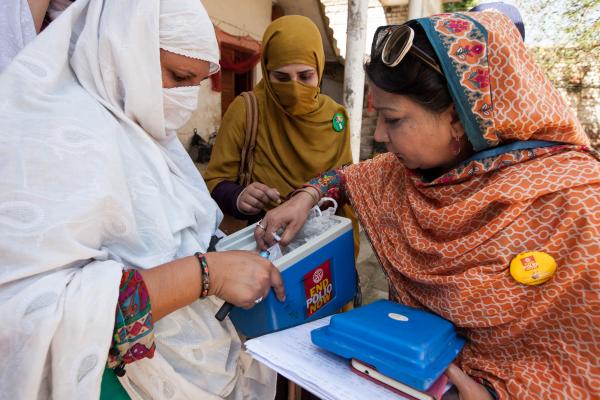
“I just contribute my part as a Rotarian. I’m happy to work in remote areas, especially with women, motivating them to play their role in society,” says Tayyaba Gul, right.
Photo by Khaula Jamil
Tayyaba Gul, a member of the Rotary Club of Islamabad (Metropolitan), Pakistan, runs a Rotary-funded health center in Nowshera, in the province of Khyber Pakhtunkhwa, where her team of female vaccinators aim to close the cultural gap that pushes up refusal rates. The group works in neighborhoods within tribal border regions among ethnic Afghan refugees. Its aim is to convince mothers that polio immunizations are a normal part of postnatal care.
“I just contribute my part as a Rotarian. I’m happy to work in remote areas, especially with women, motivating them to play their role in society,” Gul says.
Her team uses cellphones to report data, allowing members to send reports directly to the Pakistan’s National Emergency Operations Center.
Rotary also worked with leading Islamic scholars to form the Pakistan Ulema PolioPlus Committee, which is strongly behind efforts to rid the country of polio.
“The committee is doing a wonderful job at holding workshops and gathering Islamic leaders to educate them about how important these polio drops are,” Rotary’s Memon says. “We are telling them that 52 other Muslim countries have eradicated polio with the same polio drops.”
Virologist Shoukat Ullah, who is also a mufti, an Islamic legal expert empowered to rule on religious matters in his community, says outreach to Muslim leaders can make a “huge impact.”
In his city of Nowshera, Ullah attends community gatherings and Friday prayer ceremonies to talk to families and other Muslim leaders about the benefits of polio vaccinations.
“People will follow their Islamic scholars,” he says. “Community members will help volunteer … if asked by scholars. We can make a big difference in the perception of polio and any cultural barriers.”
Religious support persons encourage polio vaccinations.
Memon knows Pakistan is being singled out for its polio efforts, not just because of 2014, but also because of its progress since. “We need to complete the task,” he says. “We don’t have much time. We have to eradicate this disease fast.”
The global footprint of polio has never been smaller. While Pakistan is hoping that its last case of polio occurred in 2016, significant challenges remain. The country must continue to implement its National Emergency Action Plan at all levels, ensuring that funding is in place, enhancing surveillance quality in core reservoirs, and securing the safety of all front-line health workers.
“We look forward to the continued support of Rotary in crossing the finish line,” says Senator Farooq. “We are very, very close to finally ridding this country, the region, and globe of this menacing disease.”
The polio team in Kohat, along with the thousands more across Pakistan, has the same goal as the global health community: Reduce the 10 to 20 percent of children who are missed in vaccination campaigns to zero. It’s why they’re often pushy, rarely taking no for an answer. On average, the toll plaza team vaccinates around 800 children per day.
But refusals happen. About two in 10 vehicles flagged down do not participate in any vaccinations. Whether it’s for religious reasons, or because parents insist that their child has already received the vaccination, team members have to be ready to convince families that the drops they have in their hands are critical to reaching their goal and making history.
“With polio eradication,” says O’Leary, “there’s no other health program in the world that I’m aware of where your goal is zero in everything you do.”
From www.rotary.org



